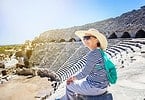I recently attended a Prosecco Superiore DOCG seminar at A Voce Columbus in New York. The sunny morning was deliciously focused on tasting the marvels of the Glera grape that delivers a crisp, fruity and bubbly taste experience with overtones of almond and citrus, melon, lemons and honey. The event was designed to share the nuances of prosecco.
The Best of Prosecco
The first mention of prosecco dates back to 1772 where it is mentioned by Francesco Maria Malvote in Giornale d’Italia (Journal of Italy, 8th volume) in his discussion of local viniculture. Today, to assist in making the correct prosecco decision, look at the label (and not the price) to determine if the Prosecco is premium; if it is – it will have DOCG on the label indicating that the Denominazion di Origine Controllata e Garantita – assuring buyers that the wine is made in the Prosecco- restricted area of Italy and has been authenticated by an independent governing organization. The Prosecco region of Italy, including Conegliano and Valdobbiadene, is north of Venice in the Vento region (near Trieste).
The European Union has ratified this designation, making it illegal for wine producers anywhere outside northeastern Italy to label their wines as Prosecco and produced using Charmat methodology.
Methodology. Charmat
1. First make a still wine from Glera grapes (may also include up to 15 percent of Bianchetta Trevigiana, Verdiso, Perera, Glera lunga or Pinot Grigio, Pinot Bianco, Pinot Nero or Chardonnay)
2. Place wine in a pressurized steel tank with sugar and yeast
3. In the tanks, yeast and sugar react to make carbon dioxide, carbonating the wine
4. Fermentation occurs in steel tanks instead of bottles, preserving the taste of grapes; resulting in a fresh, fruity flavor
5. Wines aged for months and not years
6. Low alcohol content (approximately 11 percent)
Champagne or Prosecco
Champagne is made with Chardonnay, Pinot Noir and Pinot Meunier grapes in a legally protected region of France. It is produced using the Traditional Method where the grapes experience secondary fermentation in the bottle in which it is sold, resulting in a wine with bubble subtlety that is fine, persistent and sharp; the taste is less fruity than Prosecco; age is determined by years and not months. Champagne foodies pair their selections with shellfish, raw bar, calamari or anything that is crispy and fried. Champagne is usually more expensive.
Prosecco is made in a legally protected region in Italy. It is frequently served as an aperitif before dining, an ombrette (pick-me-up) – during the day, as well as through meals and at the end of a meal – as a desert. The bubbles are light, frothy and fizzy and quickly disperse. It is best served chilled between 40 -45 degree F and consumed shortly after opening. Good match-ups include cured meats, prosciutto-wrapped melon, Thai noodles and sushi; it can also be mixed with peach puree for a Bellini. Drink prosecco while it is young (within three years of bottling), fizzy and flirty.
4 Favorites
1. Malibran. Credamora Valdobbiadene Prosecco Col Fondo DOCG 2013
Malibran is owned by Maurizio Favrel, a young prosecco owner and enologist who graduated from the G. B. Cerletti Enology School of Conegliano Veneto, the oldest and most noted school of its kind worldwide. Favrel interned for two years with a major winery in Valdobbiadene and in 2004 assumed the winemaking leadership for the family estate where he is responsible for total production, from cultivation of the grapes to the bottling of the final product.
The estate is founded on a strong bond with the terroir and loyalty to the traditional methods of winemaking. Favrel focuses on sustainable agriculture and does not use weed-killer or clarifying substances during the wine-making process.
The Prosecco vine is rustic and vigorous and the branches are hazel-brown. The sparse-berry bunches are golden yellow when ripe. The vineyards are cultivated mostly by hand with the help of simple tools using the Silvoz system. Today Malibran covers 7 hectares and produces 50,000 bottles per year.
Historically there was no technology to produce a sparkling wine. Prosecco was bottled with its lees and rested in the cellar where it fermented a second time. The residual sugars were transformed by yeast into graceful bubbles, and after a few months, it was transformed into sparkling wine. The wine was ready to be tasted, with the lees of fermentation at the bottom of the bottle (Col Fondo – Sur Lie). Malibran uses this ancient method.
To enjoy the Prosecco Col Fund, let it rest for a few days in a vertical position, allowing the sedimentation of yeasts. When it is time to serve, leave the sediment at the bottom; however, some prefer to shake the bottle before serving – putting the yeast in suspension to be enjoyed at part of the prosecco experience which includes the scent of the fermentation that took place in the bottle.
Look. Not a traditional prosecco…it is a bit cloudy to the eye with a veil of yeast giving it a hue that runs from pale yellow-to-light green (think unripe grapefruit)
Smell. Hints of citrus (limes and lemons, grapefruits and oranges), green and crab apples, brown pears, bread crusts and yeast
Taste. Flavorful, delicious, slight sour fizz, earthy minerality
Pair. Start the day (replace the grapefruit juice) or for lunch with poached salmon or cold roast chicken salad; end of day with shell fish
2. Adami. Rive di Farra di Soligo Col Credas Valdobbiadene Prosecco Superiore DOCG 2014
The Adriano Adami family has been making prosecco for almost 90 years in the town of Vidor, in the hamlet of Colbertaldo. The Adami wines were first noted in 1933.
The DOCG designation indicates that the wine is made from grapes grown in the original zone in the northern end of the Veneto region, near Valdobbiadene and Conegliano (close to Treviso). It also identifies the subzone, Rive di Farra di Soligo, indicating Made with 100 percent Glera grape, Col Credas references Credazzo, a hilly area in Farra di Soligo, where soils are identified by rich deposits of clay (or creda in the local dialect); Col Credas is one of the Rive – steep hillslope vineyards that are south and southeast facing.
The vinification process requires a light pressing with a bladder press, with gravity settling the must and fermentation taking place at a controlled temperature. The maturation on the fine lees takes place in steel tanks for 3 months with a second fermentation done by Metodo Italiano or Charmat in steel pressurized tanks (autoclave) to make it sparkling.
Look. Clear leading to a very pale yellow
Smell. Very light but definitely conjures up thoughts of “green” and a bit sour like limes and grapefruit (with a bit of honey) and a hint of lemon zest, with a touch of honeydew and peach to offset the raw-edge of the citrus
Taste. Very brut in style, tangy, lick of minerality with a crisp dry finish
Pair. Plates of salami and prosciutto and a spicy antipasti or steamed shrimp – on a spring afternoon
3. Bortolomiol. lus Naturae Valdobbiadene Prosecco Superiore DOCG Brut 2013
This winery was started by Giulio Bortolomiol who continued the work of his family who were making wine in the Veneto region since the middle of the 18th century. In 1949, near the town of Valdobbiadene. Giulio Bortolomiol graduated from the Wine School of Conegiliano as an oenologist and after WWII decided to revive the vineyards near Valdobbiadene. Devoting himself to wine making – specifically sparkling wines. In 1946 he started the Prosecco Wine Fraternity or Brotherhood of Prosecco. In 1960 he created the first Prosecco Brut (dry) – up to this point the Prosecco grape variety was used exclusively for sweet and still wines. In 1962 he organized the first national exhibition of sparkling wines of Italy, which grew into Forum Spumanti d’Italia. He experiments with method Martinotti-Sharma where the secondary fermentation takes place – not in the wine bottles but rather in the large autoclaves at a controlled temperature of 10-12 degree C.
When Giuliano died the winery continued to grow through the leadership of his wife, Octavia and his four daughters. Today the wines win awards at exhibitions and competitions including the Mundus Vini Silver Medal (2012) and the Decanter World Wine Award Bronze Medal (2014).
Organic millizimnoe white sparkling wine “lus Naturae” Brut Millesimato is synonymous with high quality and notes the unique and natural characteristics of the terroir Valdobbiadene. The family vineyards are located in the center of Valdobbiadene in the park Filandetta and processed following requirements of European organic viticulture.
To produce “lus Naturae” the Glera grapes are collected by hand for 2 days at their optimal maturity. Before soft pressing, the berries are subjected to strict control and selection. The initial fermentation takes place with the addition of special yeast at a controlled temperature. The secondary fermentation Martinotti-Charmat has a 3 month maturation period.
Look. Palest of blonde – think under-ripe lemon
Smell. Hints of oranges mixed with suggestions of lemons, grapefruit and kiwi
Taste. Lively acidity, lots of dancing bubbles that gently caress the tongue leaving a memory of fresh apples
Pair. Snails and oysters and seafood salads
4. Masottina Rive di Ogliano Valdobbiadene Prosecco Superiore DOCG Extra-Dry 2014
Founded by Epifanio Dal Bianco at the end of WWII, this pioneer understood the potential for the wine-growing region of Conegliano. The second generation of the family is moving the product to the forefront of excellent wines. Adriano, the oldest son, is motivated by the standards of quality. He graduated from the Wine School of Conegliano and worked with other companies prior to taking over the leadership of the company.
The steep slopes of the Ogliano hills and exposure to the fresh air currents from the Trevisano pre-Alps create a micro-climate that promotes healthy grapes that ripen faster and maintain a higher sugar content. On 60 hectares of estate vineyards the Rive di Ogliano develops its depth and complexity from the chalky soil.
Look. Palest of lemon yellow to white with very small bubbles
Smell. Citrus, pears with overtones of clay and fresh white flowers
Taste. Slightly sour (think ripe grapefruit) minerality and almost-ripe green grapes adds structure; full-bodied
Pair. Drink young as an aperitif or with grilled fish






















